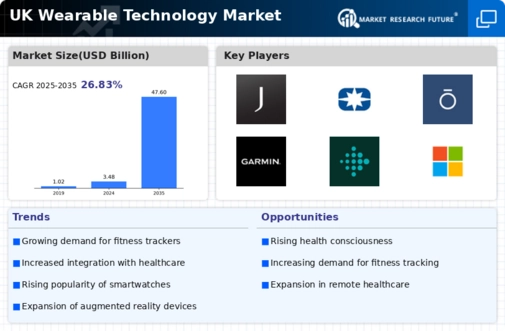The UK Wearable Technology Market is characterized by rapid advancements and an increasing consumer base that seeks convenience and connectivity through smart devices. The market continues to evolve with emerging trends such as health-focused wearables, fitness trackers, smartwatches, and augmented reality devices. Companies operating in this space are striving to differentiate themselves through innovative features, design, and user experiences that appeal to a tech-savvy population.
Competitive dynamics in the UK are driven by factors such as brand reputation, product performance, marketing strategies, and the ability to adapt to consumer preferences, resulting in a crowded yet vibrant market where technology and lifestyle intersect. Jawbone has carved out a notable presence in the UK Wearable Technology Market with its focus on health and fitness tracking products. The company has established itself as a strong player by offering innovative wearables that integrate seamlessly with mobile applications to help users monitor their health and physical activities.
One of the key strengths of Jawbone lies in its ability to provide valuable insights through data analytics, making it a preferred choice among fitness enthusiasts. Additionally, Jawbone's emphasis on sleek design and functionality aligns with the modern consumer's expectations of wearable technology, further enhancing its market position. The UK market appreciates Jawbone's commitment to quality, providing robust competition against other brands that contribute to its sustained relevance in the health-focused wearable segment. Polar has a well-defined role in the UK Wearable Technology Market, specifically known for its expertise in fitness monitoring solutions and heart rate sensors.
Offering a range of products, including running watches and cycling computers, Polar demonstrates its commitment to high-performance wearables tailored for serious athletes and casual fitness enthusiasts alike. The company's strengths in the UK lie in its longstanding reputation for accuracy and reliability, which has garnered a loyal customer base. Polar has also engaged in strategic partnerships and collaborations that enhanced its product offerings, ensuring they remain competitive in a fast-paced environment.
With an ongoing focus on innovation, including regular software updates and new product launches, Polar continues to reinforce its market presence while adapting to the dynamic demands of the UK market.























